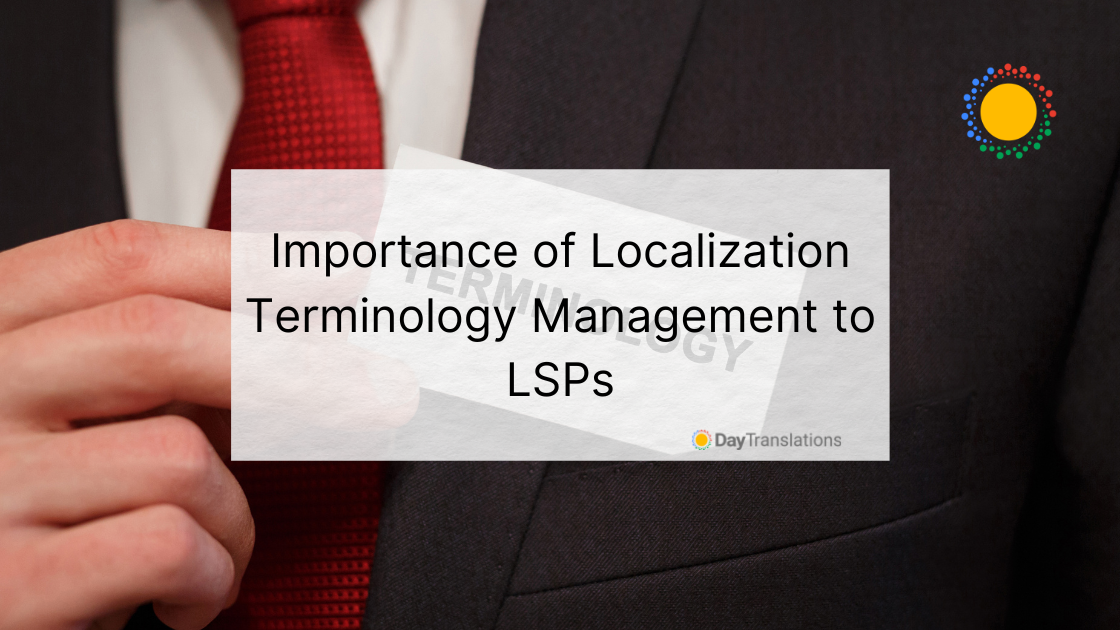Translation work varies and often, specific terms only occur once or twice in a document. But when it comes to localization, it is vital that the terminology used is consistent throughout the entire project, just like when doing translation for different specializations. We call it localization terminology management.
Terminology management in localization and translation in general, helps save time, money and energy, when occurrence of repeated terms is higher than usual. This tool works well together with CAT and translation memory tools.
The crux of using terminology management is to create a termbase or a ”database of terms” that can be updated over time. This is a list of company- or industry-specific definitions, synonyms, acronyms and abbreviation of terms in the source and target languages. The purpose of terminology management is to make the business messages standard across all translation projects for a specific client.
What is a terminology database?
A terminology database or a ”termbase” is a collection of the terms that relates to a particular subject. The terms could be in two languages or several languages, depending on the client.
In translation and in localization, it is vital that proper terminology is used to maintain the quality of the translation work. The quality of localization affects user or consumer acceptance.
Terminology is important not only to translators but also to companies that compete in the international market. The management of terminology could present a challenge to a translation company with several translation teams located in different countries. A termbase helps to ensure that all the translators across the enterprise consistently use the same terminology.
A termbase includes the following:
- Terms in the source language and in the target languages
- Description of the terms
- Explanation on the use of the terms
- Information related to grammar
Termbase and translation memory
Localization experts are very familiar with translation memory tool and termbases as they usually use both tools for their translation projects. They have some similarities as well as differences that might not be too obvious to new translators.
Translation memory tool
A translation memory is a collection of terms that were used in past translations that provide these properties:
- It automatically learns the new words that are translated
- The learning process of the tool is in real time
- It memorizes a saved translation automatically
- When a translator does another project with similar texts, the translation memory tool suggests the translations it has learned
The translation memory tool suggests fuzzy matches and exact matches. A fuzzy match means it is an approximate match based on spelling and meaning. It provides the translator with a starting point to quickly find the right term to use for the document.
An exact match means that the term or phrase is 100% exact. With exact matches the translator does not have to do any changes and can work faster on the translation project.
A termbase is the main asset in the management of terminology. It is a centralized collection of technical, product or company related and industry specific terms. It is typically shared with the members of the translation team. It needs constant updating and contains source terms and texts, approved translations and the clarifications, definitions and descriptions of each term. It also includes terms that should not be translated such as company, product or brand names.
Using a translation memory tool
When doing localization projects, a language services provider (LSP) could create a translation memory that is specific to the client. This helps the translation team when there are repeat projects from the same client. It helps minimize the cost of translation as the terms are reused. It also reduces the time spent on translation as it eliminates redundancy in translating similar texts repeatedly. With translation memory, the quality of the text increases leading to translations of higher quality. The linguistic quality is maintained for future projects even if another translator handles the work.
Using a termbase
A good termbase should have the key terminology used by the client. It should include source text, approved translations of specific terms and well-researched texts and terms specific to the industry the client is engaged in. It is better if the termbase is provided by the client. Using a termbase helps rule out ambiguities. All concerned parties on the client side and the translators can use the termbase as their guide to ensure that everyone uses the same terms. It ensures that spelling and usage of corporate terminology is correct. It speeds up the translation process because searching for specific terminology is eliminated.
Technical fields typically use their specific language. They often have specialized and uncommon terms. Without a termbase, it is difficult and time consuming to localize long content, as the translators need to keep track of all the terms used and their translation in order to be consistent.
Major benefits of terminology management
1. Consistency
The most prominent benefit from terminology management is the consistency of the terms to be used across all the translation work for each language. When the termbase is built conscientiously and updated regularly, it ensures that the message your business wants to impart will be the same when the content is localized for different markets. Because it is important to all the parties involved, most LSPs will accept the termbases, style guides and glossaries of their clients, to ensure consistency and accuracy.
2. Money and time saving
It is common for LSPs to charge translation work per word. When a client provides a well-built termbase, it helps translators and proofreaders to save time, because they do not have to build their own terminology database. It speeds up the work, lowers stress and provides a smoother flow of work. This results in a lower number of new words to be charged and reduced working hours.
3. Control in quality of translation work
The source material’s linguistic quality has a big effect on the quality of the localization and translation work. The termbase becomes a tool to determine the quality of the translation from the beginning and through the entire process of translating the source material.
4. Better and quicker proofreading
An LSP’s quality control process includes proofreading. The process ensures that inconsistencies and errors that might have occurred during the actual translation are fixed. A translation memory tool as well as a termbase will help locate these minor inconsistencies to speed up the proofreading as well as the validation process that would be done by people involved in the project. This could include native speakers of all the target languages, project managers and other proofreaders.
Benefits to clients
Localization and translation helps clients improve their brand identity and corporate image in the new foreign markets they want to explore. These benefits are the result of having consistency in translation and localization. Before translators achieve consistency, they need to have a good terminology management tool. Clients should place high importance and value to translation consistency and good quality localization of all corporate materials for foreign markets. It helps make a company maintain an image of a corporation that knows how to handle its business, knows how to respect cultures and new customers and knows how to seamlessly adapt to the linguistic needs of their new markets.
Defining terminology management
Terminology management is the process of collating company and industry specific terms systematically. It lists all the terms that appear in all of the client’s content together with their translations in other languages. It contains the examples, definitions, spelling conventions and equivalent of terms. It should also include explanations on which texts should not be translated, such as trademarked terms, proprietary names, proper names and company names.
Terminology management should start before a client requests for translation or localization, particularly when it involves technical text.
In short, you could say that terminology management is a collection of the rules that translators and other users must follow.
It is of critical importance to the translation process and a very valuable tool to maintain consistency and high quality of the project. It eliminates guesswork, confusion, and wasting time in going back and forth between client and linguists.
A good terminology management involves the input of selected members of each department in the client’s company. They should be responsible in creating the terminology database and in updating it. The database should be carefully checked to ensure that all entries are accurate, particularly the spelling and translation in other languages.
The database should have key concepts. Terms should be between 1 and 4 words without articles and prepositions. There should not be duplicate entries but include terms in singular and plural forms, as well as compound word and terms.
It is important for LSPs to have localization terminology management, as this is a great tool to assist subject matter experts in their localization work. Ensure that your localization is accurate not only in terms of terminology but also in the nuances of the target language and the cultural preferences of the target consumers by calling Day Translations. We have native speakers who are subject matter experts in different fields, such as medical, legal, literary, IT, engineering, financial and business management. It does not matter where you are as we have translators all over the world. We are open 24/7, all days of the week, to serve you faster and better. You can reach us via email at [email protected] or through phone at 1-800-969-6853












Sorry, the comment form is closed at this time.